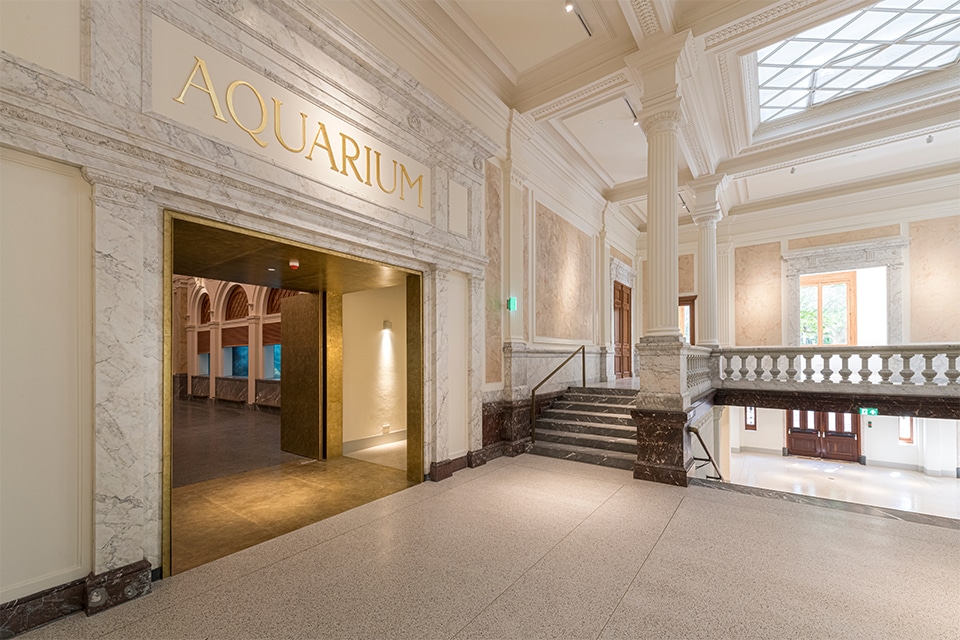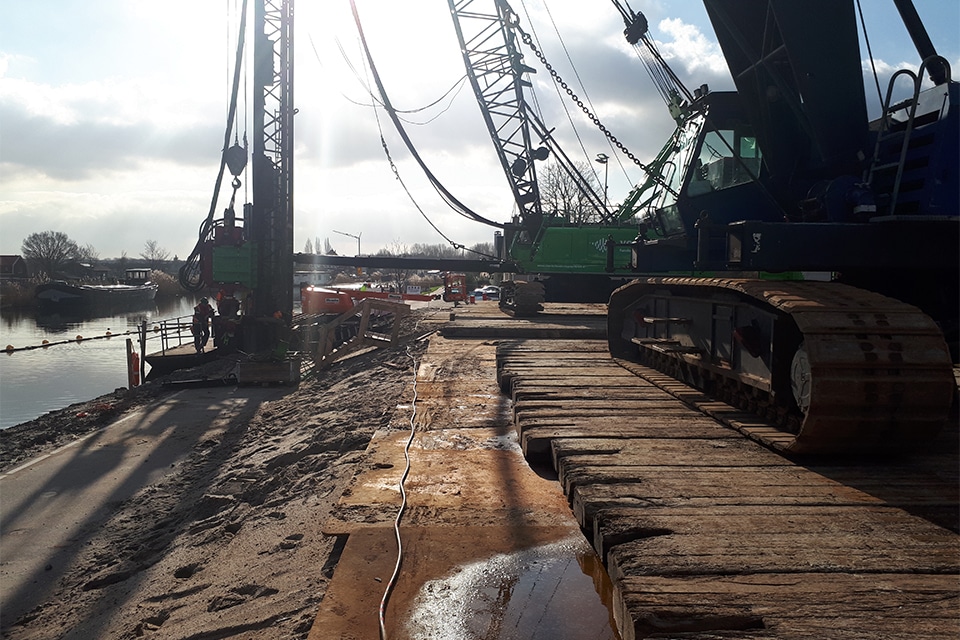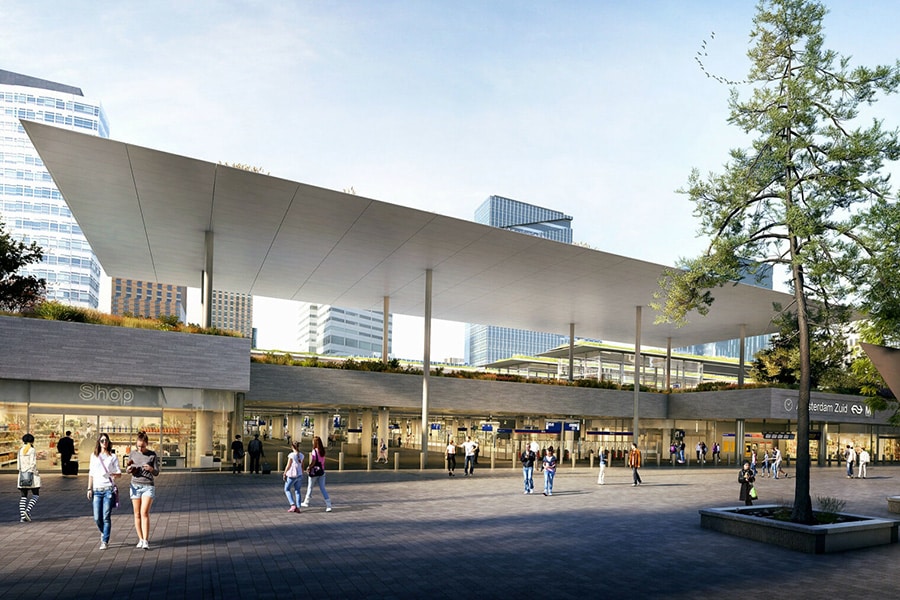
Grotius I and II: Crown jewels in Hague station area
Majestic. This is how Grotius I and II are best described. With their stately appearance and natural stone facades, which seem to crumble towards the top, they give the city entrance and skyline of The Hague new élan. Last July and September, the residential towers reached their highest point. The ultimate crowning achievement in 2.5 years of top-level construction.
Grotius I and II comprise a total of 655 rental apartments. The development is in the hands of Provast. Architectural firm MVRDV made the design, construction combination J.P. van Eesteren/BESIX is taking care of the execution. "The towers act as a spin-off for a complete makeover of the area between Utrechtsebaan and Central Station," says Provast project director Jurjen Thomas. "We saw this area as an opportunity to do something about the housing shortage. In consultation with the municipality of The Hague, this eventually led to an area vision, with the ambition: to create a lively, highly urban and at the same time park-like environment where you can enjoy living, working and recreation. This includes partly covering the Utrechtsebaan and extending the promenade to Bezuidenhout."

Completely different world
With heights of 120 and 100 meters, respectively, but certainly also because of their image-defining design, Grotius I and II are a welcome addition to The Hague's city entrance and skyline. Thomas: "Together with the municipality and the architect, we gave substance to the area vision with this building. By building two towers, we were able to play with heights and sightlines. Between the towers we also created space for a pleasant green inner area. The creativity of MVRDV, known for such architectural tours de force as the Market Hall and Depot Boijmans van Beuningen, is reflected, among other things, in the facades. These are clad in natural stone in seven different color tones, from beige to jet black, and appear to crumble on the upper floors." Cees Guijt, project manager at Provast adds, "Those upper floors literally and figuratively take the crown. The experience in that part of the towers is phenomenal. The special outdoor spaces, the finish with tongue-and-groove elements and the terraces with greenery and views make you feel like you're in a completely different world."
Varied pixelated floor structure
Since February 2019, construction combination J.P. van Eesteren/BESIX has been carrying out the new construction of Grotius I and II. A large and complex job that requires the necessary inventiveness. Superintendent Ron Nijs of BESIX explains, "The residential towers are composed of a parking basement, a plinth with commercial spaces, the middle section with apartments and finally the crown with apartments. From the second floor, we pulled the towers up with a climbing box, up to the part where the building starts to 'crumble'. In this, you have to imagine that 'pixels' have been removed from the building. This is done differently on each floor. For the climbing box, this was not convenient. So we performed most of the upper floors with traditional formwork. Again, because of that varied pixelated floor construction, this was not easy. To give you an idea: it took six months to engineer the whole thing out." Superintendent Raymond Wuister of J.P. van Eesteren adds: "To make sure the facades met the aesthetic wishes and quality requirements, we made a mockup of a pixel. Including balconies, balcony edges and connection details. We optimized that mockup in detail. This was to avoid unpleasant surprises at a height of 120 meters."

Deconstruction in three construction streams
In early July this year, Grotius II was on high alert. Grotius I followed at the end of September. Wind and waterproofing of the towers began several months before the shell was completed, closely followed by the finishing work. "We provided the building with a waterproofing layer on several floors," says Wuister. "Below that, we were able to start the finishing work, including the installation of the cast floors, interior walls, ceilings, plumbing and even kitchens and wallpaper. Thus, at Grotius I we are going up in four phases, and at Grotius II in three phases. We recently started a third finishing stream, working from top to bottom. This is to meet the targeted schedule." Nijs adds, "In terms of size and planning, you should not underestimate this work. In size, we are talking about two vertical VINEX locations that have to be realized within 39 months."
Inner-city building
Wuister emphasizes that in addition to planning, inner-city construction also requires attention. "We are dealing with a limited building space, right next to a streetcar viaduct and a busy thoroughfare. We have to impede traffic as little as possible. A logistical challenge, especially when you consider that almost four thousand trucks were needed to deliver the concrete alone!" Nijs: "We work with a ticketing system and have almost everything delivered, on demand, just-in-time." The construction site is also surrounded by the Royal Library, the temporary housing of the House of Representatives and the Courthouse. "Not the least of parties to consider," Thomas said. "We invested in a good relationship with all stakeholders from an early stage. That paid off in execution."

Safety measures
That safety is a top priority is beyond question. The new construction of the Grotius Towers is also the first major project in The Hague where the National Directive on Building and Demolition Safety came into force. Wuister: "Safety, together with quality, planning, logistics and environmental management, forms a dynamic field of forces in which you always search together for the most responsible solution. For example, we had to close off Utrechtsebaan at night several times during pile driving. In the library, we evacuated about 350 times during the piling work to ensure the safety of employees. We also work with crash decks and regularly carry out work at night for safety reasons."
Top Sports
With finishing work still in full swing, client and contractor are already looking back with pride on the work done. "We don't always think about it, but we are creating something very special here," Wuister and Nijs realize. Thomas and Guijt agree: "Grotius is a wonderful project in a dynamic environment with a lot of potential. To realize this, the building consortium is practicing top sport. In a very short period of time they have built two impressive residential towers, which will be delivered in the first and second quarter of next year. And that in a time of COVID-19, scarcity of materials and staff shortages. A huge achievement."
Sustainable heating and cooling for Grotius
A very important aspect within the design of project Grotius is of course sustainability. Roodenburg, commissioned by Eteck, is making a major contribution to this with the realization of a heat/cold plant.
An inner-city construction like this presents great challenges. The sources for the WKO had to be realized on a fairly small site. In consultation with the municipality, the sources were also relocated during the project. Roodenburg made an open hot and cold source of 80 m³ each. There is also a district heating connection, which Roodenburg connected to the WKO installation.
The residential towers are heated and cooled from the CHP plant room located in the basement of Grotius II. From there, distribution runs through the buildings to the delivery sets in the apartments. A high-temperature and changeover piping network is used because of the need for heat and cooling. The low-temperature heat pumps supply 80% of the heat demand and the high-temperature heat pump supplies 50% of the heat demand for hot water. The work is progressing very well due in part to the fine cooperation with clients and ancillary contractors.
Specialist is responsible for coordinating the installations in the construction of the residential towers
Realizing a building is not simple. For example, a basic construction with walls and roof must be put in place, after which the various installations must be integrated to turn it into a functional building. An expert is used for each of these installations. In order to properly coordinate the various disciplines, contractors often choose a specialist for installation coordination. For the realization of the Grotius I and II residential towers in The Hague, the BESIX and J.P van Eesteren building consortium called on HIJ5 Facilities.
"Our job is to check that each installer is doing their job properly and to carry out coordination between installation disciplines. Any bottlenecks are resolved quickly to avoid bigger problems and delays. Therefore, in this project we hold installation coordination meetings at set times with the various firms for electrics, WTW ventilation, sprinkler, plumbing, fire safety, overpressure installation, district heating/WKO, etc. - 6 parties in total. We also take care of the coordination with the utility companies and supervisory authorities," says senior consultant Theo Haverkamp. "Especially the large number of partners involved and the height of the towers make this project challenging. After all, certain installations and their assembly and commissioning are specifically tailored to them. For example, the dry extinguishing system had to be active at an early stage, otherwise construction above 70 meters is not allowed."
Construction consulting firm focuses on cost management of construction projects
For contractors, it is important to get a clear picture of the costs at an early stage of a project. Therefore, Metron Bouwadvies' specialists were involved in the Grotius I and II residential tower project in The Hague to determine the costs in close cooperation with J.P. van Eesteren's Calculation Department.
"From our offices in Hummelo and Vianen, we work on various architectural and civil engineering projects throughout the Netherlands for both developing and executing clients. We are responsible for testing the feasibility of a construction project, but equally provide detailed tender and executive budgets for our clients. We provide various calculations, from estimates for an initial sketch design to a working budget at the execution level, for complete projects or partial projects. If required, we also provide financial guidance during engineering," says director and construction cost consultant Toon Krechting. "We have been a regular partner of BESIX since 2007 for the calculation of its Dutch projects and have thus already calculated several high-rise projects in recent years. We therefore know the issues through and through. J.P. van Eesteren is also no stranger to us. We were engaged back in September 2017, then still in the preliminary design phase, to calculate everything together with the building consortium. We remained involved in this project afterwards, even during the implementation phase."
Complete E-installation in the hands of a specialist
For the (co-)design, engineering and realization of the complete E-installation in the Grotius I and II residential towers, the BESIX and J.P. van Eesteren construction consortium could count on the expertise of a specialist like Rijndorp Installaties from Zoeterwoude.
"As an electrical installation company, our focus is primarily on projects in utility construction and ground-level residential construction, on fire alarm systems and on service and maintenance. So we were also involved in this project in The Hague at an early stage. We provided advice and support in the design phase and were commissioned to integrate the entire E-installation into the apartments. We are also responsible for the installation of the power supply system for both residential towers, the access control as well as the cabling for the work of our fellow installers," says Frank Veltman, director at Rijndorp Installations.
"Together with the construction consortium, we also follow up on the planning for the integration of all the installations in the buildings and are thus responsible for coordinating those works and the logistics involved. This creates the necessary challenges. After all, the work of the various installation companies and the deliveries of materials must be well coordinated in order to achieve smooth operation. In this regard, good communication between all parties is crucial, especially now that all the measures around COVID-19 must also be taken into account."
Dry fire sprinkler system for both residential towers
Many buildings in the Netherlands are equipped with one or more dry risers, also known as "dry" risers and used to bring firewater from street level to the upper floors. Indeed, this is mandatory in buildings where the highest floor of a residence area is above 20 meters in height.
For buildings higher than 70 meters, such as Grotius I and II, additional facilities such as a pumping system must be integrated to get the firewater to height. For such an installation, it is best to call on a specialist. De Groot Installatiegroep called in Wilo from Westzaan to help think about that extinguishing water transport in both residential towers.
"Every building is unique and therefore requires a customized fire water system. Moreover, the requirements of the fire department must be taken into account everywhere. Thus, we were involved in the Grotius I and II project by installation company De Groot to help think about the water transport and dry extinguishing system," states Ramon van Balen of Wilo Nederland B.V. "One common pump installation was installed in the basement to supply both towers with extinguishing water via a separate pipe network. We installed the cabling of the pump installation in the basement together with the people from De Groot, who installed the pipes in the basement and the risers in the residential buildings. Our specialists were also responsible for commissioning the entire system, which has now been operating for more than 9 months. The installation is now operating in a mode for the construction phase and soon it will then be definitively commissioned to guarantee fire safety for many years to come."
Sophisticated hydraulic climbing system with custom panel formwork for fast and safe construction
For the panel formwork, climbing system and associated engineering for the Grotius I and II residential towers, the BESIX and J.P. van Eesteren construction consortium called on the experience and knowledge of PERI Benelux.
"Every project is unique, which is why our own engineers always work with the client to find a total solution. That was no different for this project. The construction consortium wanted a self-climbing formwork system to relieve the construction crane and work quickly. The municipality of The Hague placed high demands on safety for those working on the construction site and for the people around the construction site," indicates Martin Pols, sales engineer at PERI. "The MAXIMO panel formwork is used for the in-situ internal walls, while the custom VARIO GT24 panel system is used for the external walls. To ensure construction safety at all times, contractors use our RCS-C climbing system with integrated windbreak. When a floor is completed, the system's hydraulic cylinders extend so that all climbing units including the formwork can climb up one floor. This eliminates the need for the use of a construction crane. The crown of the towers was particularly challenging, but thanks to our know-how and experience we were able to engineer a well thought-out solution together with the construction consortium for this too, ensuring safety at all times."
Construction Info
Developer
Provast, The Hague
Architect
MVRDV, Rotterdam
Construction contractor
Construction combination J.P. van Eesteren/BESIX
Construction advice
Consultancy firm H. Janssen Echt BV




